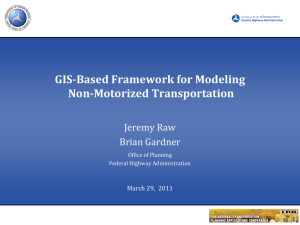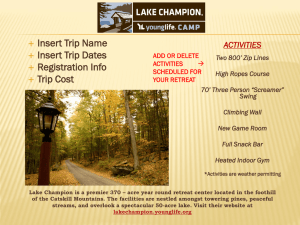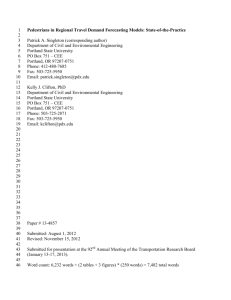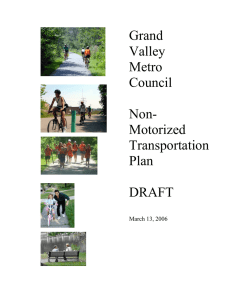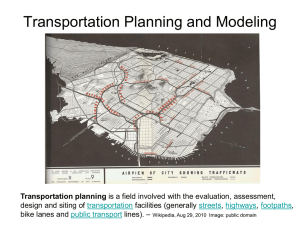Non-Motorized Model Development
advertisement
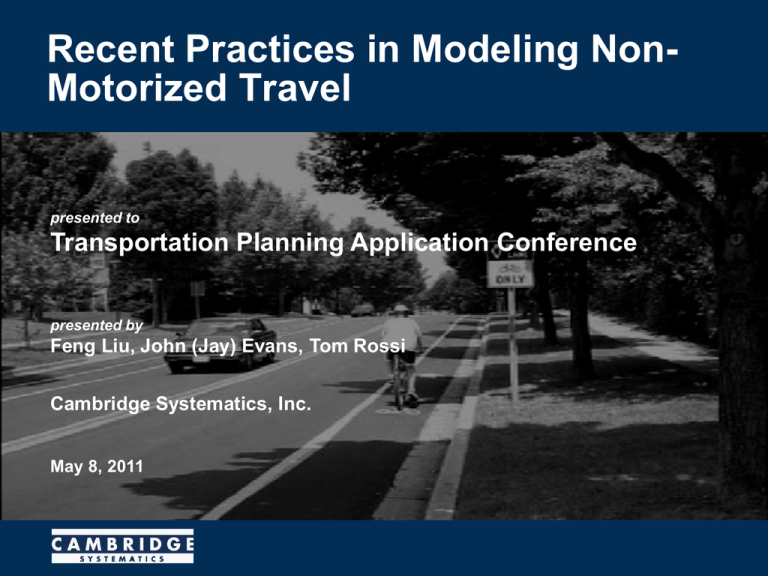
Recent Practices in Modeling NonMotorized Travel presented to Transportation Planning Application Conference presented by Feng Liu, John (Jay) Evans, Tom Rossi Cambridge Systematics, Inc. May 8, 2011 Presentation Outline Background Review of Recent Modeling Practice Modeling Approaches Lessons Learned End Notes 1 Background Modeling Non-Motorized Travel (pre-2000) • LUTRAQ 1991-1997 • Non-Motorized Travel Modeling (Rossi 2000) • Guidebook on Methods to Estimate Non-Motorized Travel (FHWA 1999; by Cambridge Systematics) • Notable practices − Metro, Portland − − − − − 2 DVRPC, Philadelphia Montgomery County, Maryland MTC, San Francisco CATS, Chicago Edmonton, Canada Recent Practices Modeling Non-Motorized Travel (post-2000) • Identified as one of eight deficiencies and one of advanced practices in TRB Special Report 288 “Metropolitan Travel Forecasting” (TRB 2007) • 16% of all responses (n=207) modeled non-motorized trips: 54% large MPOs (n=35) 16% medium MPOs (n=69) 3% small MPOs (n=103) • 38% of 34 large MPOs treated walk as a mode and 26% for bike in mode choice (VHB 2007) 3 Recent Practices Modeling Non-Motorized Travel (post-2000) • NCHRP 8-61 review of 22 large MPOs and 7 medium MPOs (2008-2010) − 45% treated walk as a mode for HBW, 41% HBO and NHB • CS’ review of recent practices in 28 large MPOs (2010-2011) − 68% incorporated non-motorized travel − 53% treated non-motorized travel as part of a mode choice model 4 Modeling Approaches Modeling Structure • • • • A: As part of trip generation B: Between trip generation and distribution C: Between trip distribution and mode choice D: As part of mode choice A 5% B 37% D 53% C 5% 5 Modeling Approaches Pros and Cons • 6 Pre-Trip Distribution Pre-Mode Choice Mode Choice Data requirements Lower (stratification need) Medium Higher (richer stratification needed) Model estimation Calibration and validation Policy sensitivity More functional forms available Likely logit structure Likely nested logit structure Trip ends only Trip ends and patterns Modal split and patterns Variables for trip ends but not for trip patterns and very limited trade-off among modes Variables for trip ends and patterns and some trade-off among modes Higher potential for evaluating trade-off among modes but actual variables used are limited Modeling Approaches Variables • Variable Type Descriptions Urban design Density, land use mix/diversity, design (street density, connectivity, continuity) Non-motorized Sidewalks, bike lanes/paths facilities Composite Pedestrian and bicycle environment factors, measures walkability index/indicator Traveler Household income, vehicle availability, student characteristics status Accessibility Proximity to activities Impedance 7 Time or distance from origin to destination Triangle Region Non-Motorized Model Development Project Project Stakeholders • Durham-Chapel Hill-Carrboro Metropolitan Planning Organization • Triangle Regional Model Service Bureau Triangle Region 8 Objectives Develop and implement enhancements to Triangle Regional Model (TRM) to • Better capture travel demand impacts of non-motorized travel (walking and bicycling) due to land use and facility/infrastructure changes • Plan for adequate non-motorized facilities/infrastructure • Gauge the effects of non-motorized trip-making on other travel modes 9 Modeling Approach: Potential Variable Categories Three potential areas were identified for new variables to be incorporated into the model: • Land use mix and density • Zonal network characteristics • Person and household characteristics 10 Enhanced Model Components Revised Trip Generation • New Survey Data − 2006 household travel survey − 2006 transit on-board survey • New Variables − Land use mix measure − Average block perimeter • Output − Total person trips − For both ends of trips 11 Enhanced Model Components Revised Trip Distribution • Existing model used composite motorized travel time • Revised model includes revised impedance variables to account for non-motorized travel 12 Enhanced Model Components Motorized/Non-Motorized Split • Explored incorporating non-motorized choice into mode choice model • Data limitation 13 Enhanced Model Components Motorized/Non-Motorized Split • Inputs − Socioeconomic indicators − Density indicators − Composite motorized time − Non-motorized distance • Outputs − Non-motorized trip tables − Provides feedback to trip distribution 14 Lessons Learned Data and Modeling Challenges • Travel survey (stratification by geography, socioeconomic strata, and mode choice) • Non-motorized infrastructure database • Mode choice model estimation • Validation data for non-motorized travel Model Sensitivity • Responses to urban design changes • Representation of non-motorized travel markets • Evaluation of specific non-motorized facility investments 15 Non-Motorized Travel Modeling Improvement Options Modeling Approach • Sensitivity to potential policy and planning evaluations Refined Geography • Non-motorized transportation analysis zones (TAZs) • Parcel-based geography • Examples 16 Non-Motorized Travel Modeling Improvement Options Refined Measurements • GIS database of non-motorized infrastructure • GPS-based household surveys with targeted non-motorized travelers • Selection of variables to minimize correlations • Measuring variables accurately in a refined geography • Quantifying and forecasting variables in an objective way 17 End Notes Contact Information Feng Liu, Ph.D. Senior Associate/Project Manager Cambridge Systematics, Inc. 4800 Hampden Lane Ste 800 Bethesda, MD 20814 (301) 347-0100 fliu@camsys.com www.camsys.com 18
